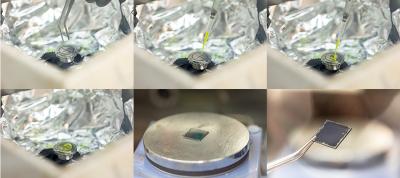Researchers from the KAUST Solar Center have monitored the impact of compositional changes on the structural organization and photovoltaic properties of perovskite thin films in situ. The team has reached a conclusion that may benefit perovskite solar cells in the future - that changes in composition affect light-harvesting layer crystallization and perovskite solar cell efficiency.
 Sequence of fabrication of a perovskite thin film from precursor solution to solid film via the spin-coating deposition process. Image by KAUST
Sequence of fabrication of a perovskite thin film from precursor solution to solid film via the spin-coating deposition process. Image by KAUST
Solar cell performance and stability depend on the morphology of the thin films, especially their ability to crystallize in the so-called photoactive α-phase. Perovskites that contain lead tend to combine various halides, such as the anionic forms of bromine and iodine, with mixtures of methylammonium, formamidinium, cesium and other cations. These have led to record conversion efficiencies and thermal stabilities compared with their single-halide, single-cation analogs. However, these mixed-halide, mixed-cation perovskite films have been characterized only through ex-situ postdeposition techniques. This limits the understanding of the mechanisms that govern their growth from their sol-gel precursor to their solid state and stalls attempts to improve device performance and stability.
'Our study provides critical insights into the crystallization of the multicomponent systems toward high-performance perovskite solar cells,' Wang says. Changes in the compositions of the halide and cation dramatically affected the solidification of the perovskite precursors during spin coating and the subsequent formation of the desired α-phase upon antisolvent addition.
The period needed to generate high-quality films by antisolvent addition ended when the sol-gel structure collapsed to produce crystalline by-products depending on the precursor mixture. Consequently, tuning the halide-cation mixture could delay this collapse, widening the antisolvent dripping window from a few seconds to several minutes. As well, simultaneously incorporating cesium and rubidium cations in the perovskite synergistically stimulated the formation of the α-phase. The length of this window showed little effect on resulting solar cell performance as long as the antisolvent was added within this period.
These findings may suggest new directions for the development of perovskite formulations that can further stabilize the sol-gel state and promote its conversion to the desirable perovskite phase. 'This is critical in achieving better-performing, reproducible, cost-efficient and scalable manufacturing of perovskite solar cells,' Wang says.
The team is working on transferring this knowledge to other deposition technologies to progress toward market-ready perovskite solar cells.

